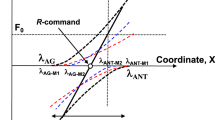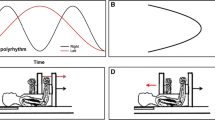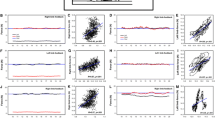Summary
In isotonic and isometric goal-directed index finger movements made as fast as possible, the “braking hypothesis” ascribed to the antagonist burst was tested. Under isotonic conditions, the extensor burst often failed to occur in small angle movements with low inertial load. It regularly occurred, however, in small angle movements with high inertial load and in wide angle movements with both low and high inertial loads. Such features suggest, indeed, the antagonist burst as being part of braking strategies. Under isometric conditions, the antagonist burst — if it occurred — exhibited characteristics which suggested a rapidly alternating movement rather than a braking strategy.
Similar content being viewed by others
References
Angel RW (1974) Electromyography during voluntary movement: the two-burst pattern. EEG Clin Neurophysiol 36: 493–498
Desmedt JE, Godaux E (1978) Ballistic skilled movements: Load compensation and patterning of the motor commands. In: Desmedt JE (ed) Cerebral motor control in man: Long loop mechanisms. Progr Clin Neurophysiol, Vol IV. Karger, Basel, pp 21–55
Freund HJ, Büdingen HJ (1978) The relationship between speed and amplitude of the fastest voluntary contractions of human arm muscles. Exp Brain Res 31: 1–12
Ghez C, Martin JH (1982) The control of rapid limb movement in the cat. III. Agonist — antagonist coupling. Exp Brain Res 45: 115–125
Hallett M, Marsden CD (1979) Ballistic flexion movements of the human thumb. J Physiol (Lond) 294: 33–50
Hallett M, Shahani BT, Young RR (1975) EMG analysis of stereotyped voluntary movements in man. J Neurol Neurosurg Psychiat 38: 1154–1162
Hopf HC, Lowitzsch K, Schlegel HJ (1973) Central versus proprioceptive influences in brisk voluntary movements. In: Desmedt JE (ed) New developments in EMG and clinical neurophysiology, Vol III. Karger, Basel, pp 273–276
Hufschmidt H-J (1952) Die rasche Willkürkontraktion. Z Biol 107: 1–24
Lestienne F (1979) Effects of inertial load and velocity on the braking process of voluntary limb movements. Exp Brain Res 35: 407–418
Lewy FH (1921) Tonusprobleme in der Neurologie. Z Ges Neurol 63: 256–270
Marsden CD, Obeso JA, Rothwell JC (1983) The function of the antagonist muscle during fast limb movements in man. J Physiol (Lond) 335: 1–13
Meinck H-M, Benecke R, Conrad B (1980a) Zur Pathophysiologie rascher isometrischer Kontraktionen bei Fingerbewegungen. In: Reisner H, Schnaberth G (eds) Fortschritte der technischen Medizin in der neurologischen Diagnostik und Therapie. Selbstverlag Neurologische Universitätsklinik, Wien, pp 265–268
Meinck H-M, Benecke R, Meyer W, Conrad B (1980b) Human ballistic index finger flexion movements: uncoupling of the three-burst pattern. Proc Int Union Physiol Sci Vol XIV, 1980, P 577
Wachholder K (1923) Untersuchungen über die Innervation und Koordination der Bewegungen mit Hilfe der Aktionsströme. II. Die Koordination der Agonisten und Antagonisten bei den menschlichen Bewegungen. Pflügers Arch Ges Physiol 199: 625–650
Waters P, Strick PL (1981) Influence of “strategy” on muscle activity during ballistic movements. Brain Res 207: 189–194
Wiesendanger M, Rüegg DG (1978) Electromyographic assessment of central motor disorders. Muscle and Nerve 1: 407–412
Author information
Authors and Affiliations
Rights and permissions
About this article
Cite this article
Meinck, H.M., Benecke, R., Meyer, W. et al. Human ballistic finger flexion: Uncoupling of the three-burst pattern. Exp Brain Res 55, 127–133 (1984). https://doi.org/10.1007/BF00240506
Received:
Issue Date:
DOI: https://doi.org/10.1007/BF00240506




